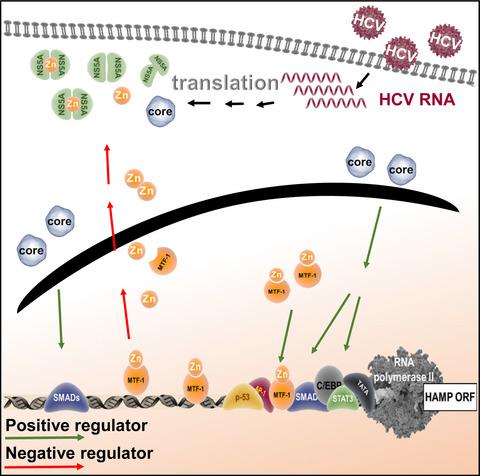当前位置:
X-MOL 学术
›
FEBS Open Bio
›
论文详情
Our official English website, www.x-mol.net, welcomes your feedback! (Note: you will need to create a separate account there.)
The Hepatitis C virus NS5A and core proteins exert antagonistic effects on HAMP gene expression: the hidden interplay with the MTF‐1/MRE pathway
FEBS Open Bio ( IF 2.6 ) Pub Date : 2020-11-28 , DOI: 10.1002/2211-5463.13048 Alexios Dimitriadis 1 , Pelagia Foka 2 , Eleni Kyratzopoulou 1 , Eirini Karamichali 2 , Stavroula Petroulia 2 , Panagiota Tsitoura 2 , Athanasios Kakkanas 2 , Petros Eliadis 1 , Urania Georgopoulou 2 , Avgi Mamalaki 1
FEBS Open Bio ( IF 2.6 ) Pub Date : 2020-11-28 , DOI: 10.1002/2211-5463.13048 Alexios Dimitriadis 1 , Pelagia Foka 2 , Eleni Kyratzopoulou 1 , Eirini Karamichali 2 , Stavroula Petroulia 2 , Panagiota Tsitoura 2 , Athanasios Kakkanas 2 , Petros Eliadis 1 , Urania Georgopoulou 2 , Avgi Mamalaki 1
Affiliation

|
Hepcidin, a 25‐amino acid peptide encoded by the HAMP gene and produced mainly by hepatocytes and macrophages, is a mediator of innate immunity and the central iron‐regulatory hormone. Circulating hepcidin controls iron efflux by inducing degradation of the cellular iron exporter ferroportin. HCV infection is associated with hepatic iron overload and elevated serum iron, which correlate with poor antiviral responses. The HCV nonstructural NS5A protein is known to function in multiple aspects of the HCV life cycle, probably exerting its activity in concert with cellular factor(s). In this study, we attempted to delineate the effect of HCV NS5A on HAMP gene expression. We observed that transient transfection of hepatoma cell lines with HCV NS5A resulted in down‐regulation of HAMP promoter activity. A similar effect was evident after transduction of Huh7 cells with a recombinant baculovirus vector expressing NS5A protein. We proceeded to construct an NS5A‐expressing stable cell line, which also exhibited down‐regulation of HAMP gene promoter activity and significant reduction of HAMP mRNA and hepcidin protein levels. Concurrent expression of HCV core protein, a well‐characterized hepcidin inducer, revealed antagonism between those two proteins for hepcidin regulation. In attempting to identify the pathways involved in NS5A‐driven reduction of hepcidin levels, we ruled out any NS5A‐induced alterations in the expression of the well‐known hepcidin inducers SMAD4 and STAT3. Further analysis linked the abundance of intracellular zinc ions and the deregulation of the MTF‐1/MRE/hepcidin axis with the observed phenomenon. This effect could be associated with distinct phases in HCV life cycle.
中文翻译:

丙型肝炎病毒 NS5A 和核心蛋白对 HAMP 基因表达产生拮抗作用:与 MTF-1/MRE 通路的隐藏相互作用
铁调素是一种由HAMP基因编码的 25 个氨基酸的肽,主要由肝细胞和巨噬细胞产生,是先天免疫的介质和中枢铁调节激素。循环铁调素通过诱导细胞铁输出蛋白 ferroportin 的降解来控制铁外流。HCV 感染与肝铁超负荷和血清铁升高有关,这与抗病毒反应差有关。已知 HCV 非结构 NS5A 蛋白在 HCV 生命周期的多个方面发挥作用,可能与细胞因子一起发挥其活性。在这项研究中,我们试图描述 HCV NS5A 对HAMP基因表达的影响。我们观察到用 HCV NS5A 瞬时转染肝癌细胞系导致HAMP启动子活性。在用表达 NS5A 蛋白的重组杆状病毒载体转导 Huh7 细胞后,类似的效果很明显。我们着手构建表达 NS5A 的稳定细胞系,该细胞系还表现出HAMP基因启动子活性的下调和HAMP的显着降低mRNA和铁调素蛋白水平。HCV 核心蛋白(一种充分表征的铁调素诱导剂)的同时表达揭示了这两种蛋白质之间对铁调素调节的拮抗作用。在试图确定 NS5A 驱动的铁调素水平降低所涉及的途径时,我们排除了任何 NS5A 诱导的众所周知的铁调素诱导剂 SMAD4 和 STAT3 的表达改变。进一步的分析将细胞内锌离子的丰度和 MTF-1/MRE/铁调素轴的失调与观察到的现象联系起来。这种影响可能与 HCV 生命周期的不同阶段有关。
更新日期:2021-01-04
中文翻译:

丙型肝炎病毒 NS5A 和核心蛋白对 HAMP 基因表达产生拮抗作用:与 MTF-1/MRE 通路的隐藏相互作用
铁调素是一种由HAMP基因编码的 25 个氨基酸的肽,主要由肝细胞和巨噬细胞产生,是先天免疫的介质和中枢铁调节激素。循环铁调素通过诱导细胞铁输出蛋白 ferroportin 的降解来控制铁外流。HCV 感染与肝铁超负荷和血清铁升高有关,这与抗病毒反应差有关。已知 HCV 非结构 NS5A 蛋白在 HCV 生命周期的多个方面发挥作用,可能与细胞因子一起发挥其活性。在这项研究中,我们试图描述 HCV NS5A 对HAMP基因表达的影响。我们观察到用 HCV NS5A 瞬时转染肝癌细胞系导致HAMP启动子活性。在用表达 NS5A 蛋白的重组杆状病毒载体转导 Huh7 细胞后,类似的效果很明显。我们着手构建表达 NS5A 的稳定细胞系,该细胞系还表现出HAMP基因启动子活性的下调和HAMP的显着降低mRNA和铁调素蛋白水平。HCV 核心蛋白(一种充分表征的铁调素诱导剂)的同时表达揭示了这两种蛋白质之间对铁调素调节的拮抗作用。在试图确定 NS5A 驱动的铁调素水平降低所涉及的途径时,我们排除了任何 NS5A 诱导的众所周知的铁调素诱导剂 SMAD4 和 STAT3 的表达改变。进一步的分析将细胞内锌离子的丰度和 MTF-1/MRE/铁调素轴的失调与观察到的现象联系起来。这种影响可能与 HCV 生命周期的不同阶段有关。

























 京公网安备 11010802027423号
京公网安备 11010802027423号